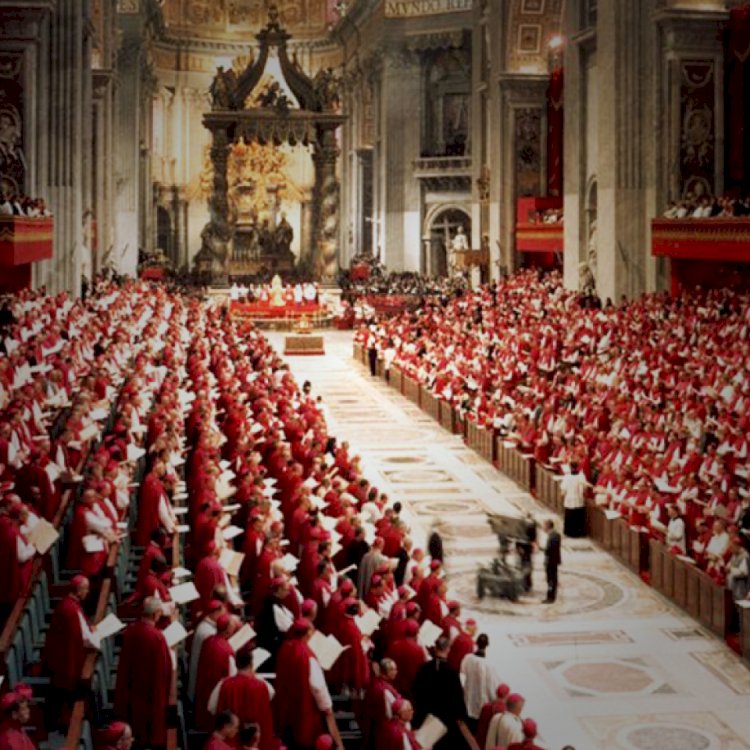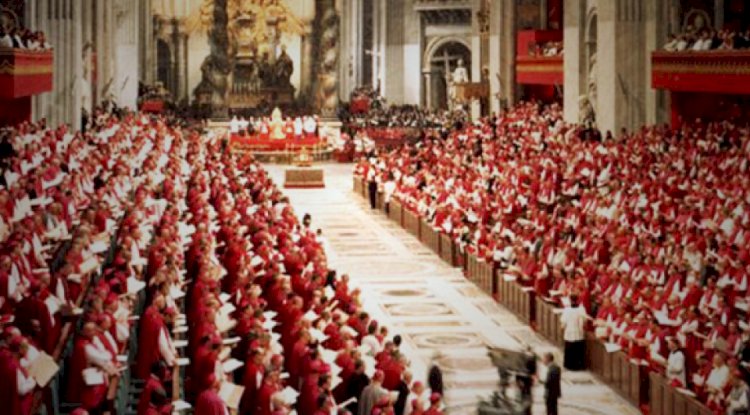Vatican 2 Changes To Modernize The Church

Matthews Otalike, 7/5/25
The Conclave to elect a new Pope opens today with the assembly of 133 Cardinals below the age of 80 years. I thought there is the need to look back first, over the changes wrought by the Second Vatican Council which Pope Francis upheld and what may likely follow in the nextr pontificate.

The Second Vatican Council, or Vatican II, was convened by Pope John XXIII from 1962 to 1965 to renew and modernize the Catholic Church. It produced 16 key documents that addressed various aspects of Church life, aiming to make it more relevant to the modern world while preserving core doctrines.

Pope John XXIII (convened the Vatican II in 1962)
Liturgical Changes
Vatican II reformed the liturgy to enhance lay participation. The Mass could now be celebrated in local languages instead of Latin, making it more accessible. Altars were turned so priests faced the congregation, and the liturgical calendar was simplified, with more Scripture readings included.
Role of the Laity
The council gave laypeople a larger role, allowing them to serve as readers, ministers of Communion, and participate in decision-making bodies like parish councils. This shift emphasized the Church as the "people of God," inclusive of all believers.
Ecumenism and Dialogue
Vatican II promoted dialogue with other Christian denominations and non-Christian religions, condemning antisemitism and recognizing the value of other faiths. It also proclaimed religious freedom as a human right, a significant change from previous teachings.
Social Engagement
The council addressed modern social issues, such as human dignity, social justice, and peace, positioning the Church to engage with contemporary challenges like poverty and human rights.
Governance and Education
Reforms included establishing episcopal conferences for collaborative governance, renewing religious life, and affirming the Church's right to Catholic schools, adapting to modern needs.
Survey Note: Detailed Analysis of Vatican II Reforms
The Second Vatican Council, commonly referred to as Vatican II, was a pivotal event in the history of the Catholic Church, convened by Pope John XXIII from October 11, 1962, to December 8, 1965. Its primary aim was to renew and modernize the Church, making it more relevant to the contemporary world while preserving its core doctrines. The council produced 16 key documents—4 constitutions, 9 decrees, and 3 declarations—that introduced significant reforms across liturgical, ecclesiastical, ecumenical, and social dimensions. Below is a comprehensive analysis of these reforms, their historical context, and their impact, as of May 7, 2025.

Historical Context
Vatican II was announced by Pope John XXIII on January 25, 1959, for spiritual renewal and Christian unity, marking the first council to allow women as observers. Sessions were convened annually under Popes John XXIII and Paul VI, with over 2,000 bishops participating. The council addressed the Church's perceived rigidity and insularity, responding to challenges like secularism, the rise of communism, and post-World War II societal changes. It aimed to implement aggiornamento (updating), as seen in Pope John XXIII's call to "open the windows and let fresh air come in," symbolizing openness to modern ideas.
Key Reforms and Changes
The reforms can be categorized into several areas, detailed below with specific documents and their impacts:
Liturgical Reforms
The Constitution on the Sacred Liturgy (Sacrosanctum Concilium), approved on November 22, 1963, with a vote of 2,159 to 19, was the first document ratified. It emphasized active participation by all, proposing:
Mass Changes: Simplified rites, increased Scripture readings, restored the prayer of the faithful, allowed concelebration, and permitted communion under both kinds for laity.
Vernacular Use: Authorized the use of local languages instead of Latin, making the liturgy more accessible. This was reflected in the 1970 Roman Missal, which introduced a new cycle of readings and simplified the liturgical calendar.
Sacraments: Simplified rites for clarity, restored the catechumenate for adult baptism, and renamed extreme unction to anointing of the sick.
Cultural Adaptation: Allowed local practices, encouraging communal singing and modern instruments like organs, while preserving Gregorian chant.
Practical Changes: Included Mass versus populum (priests facing the congregation), revised Eucharistic prayers, and modern liturgical music/artwork.
These changes, as noted in Vatican News, increased active liturgical participation, particularly in local communities, with lay readers and ministers of Communion becoming common.
Ecclesiastical and Doctrinal Reforms
Dogmatic Constitution on the Church (Lumen Gentium), approved on November 19, 1964, with a vote of 2,134 to 10, described the Church as the "people of God," emphasizing the universal call to holiness and collegiality of bishops. It balanced the hierarchical structure by recognizing other Christian communities as imperfectly in communion, potentially effective vehicles of grace.
Dogmatic Constitution on Divine Revelation (Dei Verbum), approved on November 18, 1965, with 27 negative votes, emphasized Scripture as the "soul of theology," ending Counter-Reformation anti-Modernism and increasing biblical readings in liturgy, translated into vernacular.
Pastoral Constitution on the Church in the Modern World (Gaudium et Spes), approved on December 7, 1965, with 11% opposition, addressed the Church as a "pilgrim people of God" and "communion," responsive to modern signs of the times, discussing human dignity, solidarity, marriage, culture, social justice, war, and peace.
Role of the Laity and Church Governance
Decree on the Apostolate of the Laity (Apostolicam Actuositatem) expanded lay involvement, encouraging their role in spreading the Gospel and social justice.
Decree on the Bishops’ Pastoral Office in the Church (Christus Dominus), approved on October 28, 1965, established the Synod of Bishops and episcopal conferences, giving bishops greater responsibility.
Decree on the Ministry and Life of Priests (Presbyterorum Ordinis) described priests as "brothers" to the laity, promoting lay dignity and involvement.
Practical Changes: Included establishing national/regional episcopal conferences, restoring the permanent diaconate open to married men, and allowing limited sharing in worship/communion with other Churches.
Ecumenism and Interfaith Dialogue
Decree on Ecumenism (Unitatis Redintegratio), approved on November 19, 1964, with a vote of 2,054 to 64, promoted dialogue with other Christians, reversing pre-conciliar hostility and acknowledging Catholic faults in past separations.
Declaration on the Relation of the Church to Non-Christian Religions (Nostra Aetate), approved on October 15, 1965, with a vote of 1,763 to 250, condemned antisemitism, recognized Judaism's legitimacy, and extended dialogue to Islam, Hinduism, and Buddhism.
Declaration on Religious Freedom (Dignitatis Humanae), approved on September 21, 1965, with a vote of 1,997 to 224, proclaimed religious freedom as a human right, breaking with tradition.
Social and Cultural Engagement
Gaudium et Spes addressed modern social issues, opposing euthanasia, abortion, and birth control, while affirming the Church's mission to sanctify the world.
Decree on the Instruments of Social Communication (Inter Mirifica), approved with 25% rejection, encouraged ethical media use, though considered weak.
Renewal of Religious Life and Education
Decree on the Adaptation and Renewal of Religious Life (Perfectae Caritatis), approved on October 28, 1965, renewed religious orders, simplifying habits, emphasizing education, and ensuring poverty.
Declaration on Christian Education (Gravissimum Educationis) affirmed the Church's right to Catholic schools and parental choice, though considered weak with a 9% rejection rate.
Missionary Activity and Evangelization
Decree on the Missionary Activity of the Church (Ad Gentes) focused on evangelization, training missionaries, and forming communities.
Impact and Numbers
The council's documents had significant impacts, with approval votes ranging from 1,598 to 2,344 yes, and 2 to 503 no, depending on the document. Key vote margins included:
Lumen Gentium: 2,134 to 10 (November 19, 1964).
Dei Verbum: 2,081 to 27 (November 18, 1965).
Sacrosanctum Concilium: 2,159 to 19 (November 22, 1963).
Gaudium et Spes: 2,111 to 251 (December 7, 1965), with 11% opposition.
These reforms, transformed the Church from an exclusive to an inclusive institution, recognizing the entire community of Catholic believers as the "people of God."
Controversy and Interpretations
The reforms sparked controversy, with traditionalists arguing they led to a loss of tradition, citing declines in Mass attendance (e.g., U.S. from 74% in 1958 to 17% in 2020, per Gallup) and vocations (e.g., U.S. priestly ordinations from 1,575 in 1965 to 450 in 2022, per CARA), as seen in MyCatholicSource. Progressives, however, saw them as essential for relevance, advocating for continued openness.
Contemporary Relevance
As of May 7, 2025, Vatican II's legacy continues, with Pope Francis emphasizing synodality and engagement with modern issues, echoing the council's vision. Recent analyses, such as Vatican News, highlight its impact on Church growth in Africa and Asia, while challenges in Western countries underscore the need for renewal.
Detailed Table of Key Documents and Reforms
|
Document |
Date of Approval |
Vote (Yes to No) |
Key Reforms |
|
Sacrosanctum Concilium |
1963-Nov-22 |
2,159 to 19 |
Vernacular liturgy, lay participation, simplified rites, cultural adaptation. |
|
Lumen Gentium |
1964-Nov-19 |
2,134 to 10 |
Church as "people of God," collegiality, universal holiness. |
|
Dei Verbum |
1965-Nov-18 |
2,081 to 27 |
Scripture central to theology, openness to biblical scholarship. |
|
Gaudium et Spes |
1965-Dec-07 |
2,111 to 251 |
Church in modern world, social justice, human dignity. |
|
Unitatis Redintegratio |
1964-Nov-19 |
2,054 to 64 |
Ecumenism, dialogue with other Christians. |
|
Nostra Aetate |
1965-Oct-15 |
1,763 to 250 |
Condemned antisemitism, dialogue with non-Christian religions. |
|
Dignitatis Humanae |
1965-Sep-21 |
1,997 to 224 |
Religious freedom as human right. |
|
Christus Dominus |
1965-Oct-28 |
2,167 to 14 |
Synod of Bishops, episcopal conferences. |
|
Perfectae Caritatis |
1965-Oct-28 |
(Not specified) |
Renewal of religious life, simplifying habits, and education. |
This table summarizes the key documents and their reforms, reflecting the council's broad scope.
Conclusion
Vatican II's reforms modernized the Catholic Church, enhancing lay participation, promoting ecumenism, and engaging with social issues. While controversial, with traditionalists and progressives holding differing views, its legacy remains central to the Church's identity as of May 7, 2025, shaping its mission in a globalized world.
Sources:
Second Vatican Council Wikipedia entry
Vatican II mixed legacy NPR article
Second Vatican Council Britannica overview
Summary changes since Vatican II MyCatholicSource
What's Your Reaction?














